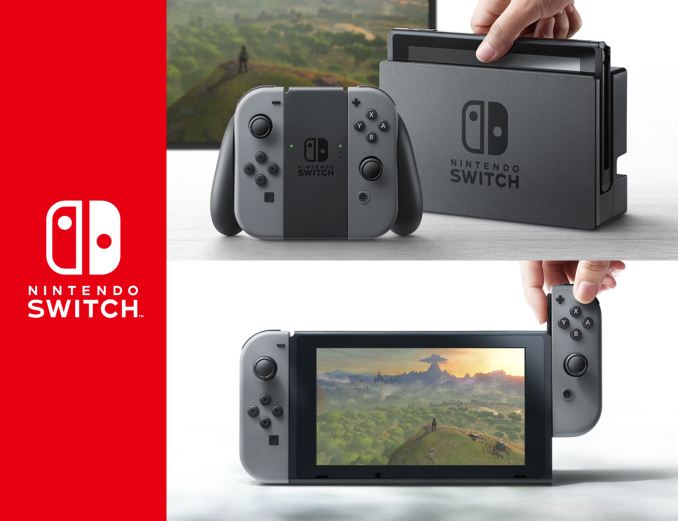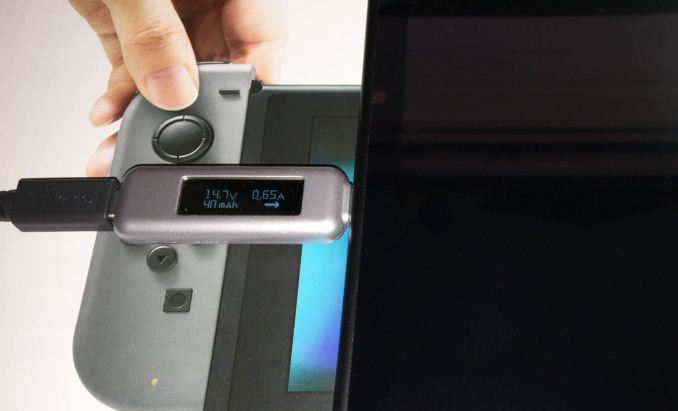Playing With Power: A Look At Nintendo Switch Power Consumption
by Ryan Smith on March 6, 2017 12:00 PM EST
Last week was of course the launch of Nintendo’s eagerly anticipated Switch console. The company’s latest handheld console, the Switch is a bit of an odd duck in pretty much every way. It departs from Nintendo’s traditional and well-established clamshell design in favor of a larger tablet, and under the hood Nintendo has stepped away from their typical highly-custom low-power SoC in favor of a rather powerful Tegra design from NVIDIA. Given that the 3DS was essentially an ARMv6 + OpenGL ES 1.x device, I can’t overstate just how significant of a jump this is under the hood in going to the ARMv8 + OpenGL ES 3.2/Vulkan class Tegra SoC. Nintendo has essentially jumped forward 10 years in mobile technology in a single generation.
| Handheld Game Console Specification Comparison | ||||||
| Nintendo Switch | New Nintendo 3DS XL | Sony PlayStation Vita Slim | ||||
| SoC | CPU | 4x ARM Cortex-A57 | 4x ARM11 | 4x ARM Cortex-A9 | ||
| GPU | NVIDIA Maxwell (256 Cores) |
DMP PICA200 | IMG PowerVR SGX 543MP4 | |||
| Display | 6.2-inch 1280x720p LCD (HDMI: 1080p60) |
Top: 4.9-inch 800x240 Bottom: 4.2-inch 320x240 |
5-inch 960x544 IPS LCD |
|||
| Size | 102 x 239 x 13.9 mm, 297g (tablet only) 398g w/Joy-Cons |
160 x 93.5 x 21.5 mm, 329g | 85.1 x 183.6 x 15 mm, 219g | |||
| Battery | 4310mAh (16Whr) 2.5 to 6.5 Hours |
1750mAh (6.5Whr) 3.5 to 7 Hours |
2210mAh (8.2Whr) 4 to 6 Hours |
|||
| Storage | 32GB NAND + microSDXC | 1GB NAND + microSDHC | 1GB NAND or Proprietary Card | |||
| Wireless | 2.4/5GHz 2x2 802.11ac Bluetooth 4.1 |
802.11g | 2.4GHz 802.11n Bluetooth 2.1 |
|||
| I/O | Console | USB Type-C | Proprietary (USB Compatible) | Micro-USB | ||
| Dock | 1x USB 3.0 2x USB 2.0 1x HDMI 1.x 1x USB-C (power only) |
|||||
| Launch Date | 03/03/2017 | 10/14/2014 | 10/10/2013 | |||
| Launch Price | $299 | $199 | $199 | |||
In any case, in between benchmark runs for other projects over the weekend, I’ve been poking and prodding at the Switch to see if there was anything interesting to find. Nintendo still hasn’t disclosed low-level specifications – nor was I expecting them to – so Digital Foundry’s unofficial analysis remains the best we’re going to see for now. And for a look at the physical layer, iFixit has once again done another one of their wonderful teardowns with the Switch, identifying many of its supporting chips and confirming that the “HD Rumble” motor is indeed a linear actuator, though oddly enough one that works on its short axis instead of its long axis.
Meanwhile thanks to some proxy shenanigans, I’ve been able to get the Switch to run some of our JavaScript benchmarks. The console ships with an integrated, stripped-down version of WebKit for use with various web services, though there’s no proper web browser exposed to the user. However this stripped-down browser clearly isn’t meant for full-on web browsing; with a Kraken 1.1 run time of 172-thousand milliseconds (~2% the throughput of a Tegra-based Pixel C), I suspect the browser isn’t even doing native JS compilation and instead is doing interpretation. So at least for the moment, there’s not much in the way of meaningful benchmarking that can be done.
Nintendo Switch: Playing With Power
However one area that I have had some success with is power measurement. And this is another area where the Switch is a bit of an odd duck, leading to some confusion around the Web judging from some of the comment posts I’ve seen elsewhere. USB Type-C has been shipping in devices for a couple of years now, so it’s hardly a new standard, but given the slow upgrade cycle of PCs and smartphones it still isn’t an interface that the majority of consumers out there have dealt with. Furthermore due to its use case as a game console, the Switch is unlike any other USB Type-C device out there (more on this in a second). So I opted to spend some time profiling the device’s power consumption, in order to shed some light on what to expect.
First off then, what makes the Switch such an odd duck here? This is merely anecdotal, but one of the big hang-ups I’m seeing is that a lot of people aren’t accustomed to using what’s essentially a high-power tablet that’s running at fill-tilt at all times. The secret to the long battery life (and clockspeed turboing) of the iPad and other tablets relative to their size is that they spend the vast majority of their time idling. It doesn’t take a lot of energy at the SoC level to display text or watch a video; the SoC is only called on in short bursts to render something before it goes back to sleep. The Switch, on the other hand, spends the vast majority of its time gaming, meaning the SoC is frequently in its highest power state.
The fact that the Switch lives most of its life at two extremes – asleep or running at full speed – means that it’s a bit unintuitive what to expect from it when it comes to power consumption. Or, for that matter, what to expect when charging it. So, in what’s ultimately an excuse for me to play with a new toy, Satechi’s USB Type-C power meter, I’ve been profiling the power consumption between the Switch and its AC adapter. As a bit of a heads up, the Satechi meter isn’t perfect – the device has to draw a bit of power itself – so if I wanted to be more rigorous about this I’d need to do a proper multimeter setup. But for some quick testing, Satechi’s meter works well enough, especially given the fact that its own power consumption is a drop in the bucket compared to the Switch’s.
Finally, looking at the specifications of the Switch, there are two numbers I want to point out. The first is the power rating of the console’s AC adapter: 15V @ 2.6A, or 39 Watts. This power adapter is quite powerful, more powerful in fact than the 29W adapter Apple includes with the modern 12-inch MacBook. Meanwhile the second number I want to point out is stamped into the bottom of the dock, and that’s the output power rating of the USB-C male port built into said dock for the Switch to connect to. It’s only rated for 15V @ 1.2A, for a total of 18W.
The difference between the two is due to the fact that the Switch dock itself plays host to 3 USB Type-A ports, including a USB 3.0 port on the rear. As a result the power adapter for the Switch apparently needed to be quite a bit oversized to ensure that it never faces a load larger than it can handle. Besides running the Switch, it also potentially needs to be able to power a USB hard drive and charge a couple of Pro Controllers, all of which can add up quickly. Consequently it’s the Dock’s output rating of 18W that’s the more meaningful number as far as Nintendo’s own specifications go.

The Switch's Dock (Image Courtesy iFixit)
Anyhow, that’s enough rambling on background information. Let’s look at the power numbers.











61 Comments
View All Comments
tipoo - Monday, March 6, 2017 - link
Chipworks promised a die scan for this today, should be exciting. At what looks like 121mm2, it's too spookily close to TX1 for me to expect much difference, but it will be interesting to see what areas they touched.TX1 couldn't use both core clusters at once for example, so without changing that the OS would have to reside on an A57 core, so I wonder if they either updated the CCI, or removed the A53s.
zunaidahmed - Monday, March 6, 2017 - link
Still waiting for the die image, should clear up all the smoke from the battle between bashers and fanboys. This is getting way too ridiculous.tipoo - Monday, March 6, 2017 - link
Yeah, I think the only realistic hope is that they touched on the memory controller and caches, at the same die size the GPU and CPU configs are pretty well sure, between that and the leaks. Anyone expecting a heavily customized chip will be let down, anyone expecting a fully stock TX1 is also misleading a bit.zodiacsoulmate - Tuesday, March 7, 2017 - link
when is the die shot coming? Im not familiar with chipwork website i'm so confused looking at it...tipoo - Tuesday, March 7, 2017 - link
They said Monday, but that didn't happen, so who knows. Today or tomorrow I'm hoping, unless they found something significantly different that they had to work harder on annotating? Not likely though.tsk2k - Wednesday, March 8, 2017 - link
Let me know when it does!tipoo - Monday, March 6, 2017 - link
That idle wattage use would be eyebrow raising for a tablet, I think the iPad Air 2 was at 2.7 watts or something with a larger, higher res screen.Murloc - Monday, March 6, 2017 - link
yeah but I guess that as a gaming console idle power does not matter.eddman - Monday, March 6, 2017 - link
Where are the idle numbers? All I can find are charging numbers.tipoo - Monday, March 6, 2017 - link
If a 100% charged Switch is pulling 11 watts from the battery, that would indicate it's discharging at 11 watts, I think.